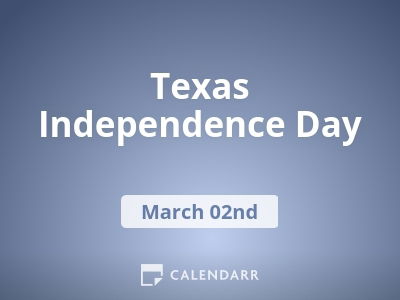- Calendar
- Calendar 2026
- March
- Texas Independence Day
Texas Independence Day
Texas Independence Day is celebrated on March 2nd, celebrating the enactment of the Texas Declaration of Independence in 1836. This was signed by 59 Texan delegates, and it declared Mexican Texas' independence from Mexico, into its own Republic of Texas. Even though it is a Public Holiday in Texas, it is considered a Partial Staffing Holiday, meaning that businesses and schools are still open but with fewer staff.
The History of Texas' Independence
The land that would become Texas had been disputed territory since the 16th century, and a total of six countries have ruled the area at different points in history.
It became a part of Mexico in 1821, when Mexico gained independence from Spain and claimed Texas as their own.
The Mexican government, seeking to populate the vast land of Texas, welcomed American homesteaders.
In 1825, Stephen Austin established the first American colony, attracting a growing number of settlers that soon surpassed the Mexican population.
Tensions arose as the American newcomers identified as Texans, leading to conflicts with the Mexican government.
Tensions escalated after the Freedonia Rebellion in 1826, which made the Mexican government take measures to stop the influx of Americans coming into Texas.
Stephen Austin then asked for statehood for Texas, which was denied by the government. Texans ignored these orders and declared statehood anyway, resulting in Austin's arrest.
The year 1827 saw Mexican dictator Santa Anna rise to power. Intending to stop the Texan revolution, he ordered that all armory should be removed from the population in Gonzales. However, when the Mexican army arrived in the town to retrieve the cannon, they were met with open fire from the Texans.
As a response to this invasion, the Americans formed a provisional state government and raised an army led by Sam Houston.
Wanting to fight for independence, some Texan troops settled in the military fort of The Alamo. Colonels Travis and Bowie had recruited 140 men to fight, and Davy Crockett arrived from Tennessee with 14 men.
They fought the 3000 men Mexican army led by Santa Anna for two weeks. At the beginning of March, some Texans managed to make their way into the Alamo, raising the number of Texan fighters to 185.
On the following day, March 2, the Republic of Texas declared independence from Mexico.
On March 6 the Mexican army managed to invade the Alamo and killed most of the American soldiers. The Fall of the Alamo then became a fighting call for the revolution, and six weeks later Sam Houston led a large Texan Army into Mexico, defeating the Mexican Army and capturing Santa Anna. “Remember the Alamo” was the war chant of the revolution. Santa Anna was forced to recognize Texas as independent or face the death penalty. He granted independence to the Republic of Texas and retreated to Mexico.
After 10 years of independence, the Republic of Texas, vulnerable to Mexican attacks, joined the United States in 1845, becoming the 28th state.
Texas Independence Day Celebrations
A day of great pride for Texans, Texas Independence Day is celebrated with parades and big fireworks displays. Most people choose to spend the day with family throwing barbecues. Others decide to visit the Historic Sites of the Texan Revolution battles, where you can get a lot of information on the history of Texas' Independence. There are also festivals around the state that feature traditions such as chili cooking contests and battle re-enactments.
On this day, most people fly the Texas Lone Star Flag in front of their homes and businesses, one of the most prominent symbols of the revolution.
Key Points Of Texas Independence Day
- The original draft of the Texas Declaration of Independence was allegedly written overnight on the back of a buffalo hide, adding an element of urgency and resourcefulness to the historical document.
- Emily West, a woman captured by Mexican forces during the Runaway Scrape, is believed by some to have played a role in gathering intelligence that contributed to the Texan victory at the Battle of San Jacinto.
- The Republic of Texas had its own navy, known as the Texas Navy, which played a crucial role in protecting the coastline and securing the independence of the fledgling nation.
- Sam Houston, the first elected president of the Republic of Texas, had a complex relationship with the Texan independence movement. He initially opposed secession from Mexico but later became a key military and political figure in the struggle for independence.
- The first and only Vice President of the Republic of Texas, Lorenzo de Zavala, was a Mexican statesman who switched allegiance to the Texan cause and made significant contributions to the drafting of the Texas Declaration of Independence.
- The exact identity of the person who designed the iconic Lone Star flag of the Republic of Texas remains uncertain, adding an element of mystery to one of Texas's enduring symbols.
The land that would later become Texas was disputed territory, with six different countries ruling the area at various points.
Mexico gained independence from Spain and claimed Texas as its own in 1821.
Stephen Austin established the first American colony in Texas, attracting a growing number of settlers in 1825.
Tensions arose after the Freedonia Rebellion, leading to measures by the Mexican government to control the influx of Americans in 1826.
Mexican dictator Santa Anna rose to power, and tensions between the Texans and the Mexican government intensified.
The conflict escalated with the Texans forming a provisional state government and raising an army led by Sam Houston.
Texans, led by Colonels Travis and Bowie, defended the Alamo against a Mexican army led by Santa Anna for two weeks. On March 2, the Republic of Texas declared independence.
On March 6th of the same year, The Fall of the Alamo occurred, becoming a rallying cry for the Texan revolution.
On April 21st, 1836, Sam Houston led a Texan Army into Mexico, defeating the Mexican Army and capturing Santa Anna. The phrase “Remember the Alamo” became a war chant.
The Treaties of Velasco were signed on May 14, 1836. These treaties marked the conclusion of the Texas Revolution and established the terms for the withdrawal of Mexican forces and the recognition of the Republic of Texas as an independent nation.
Faced with the prospect of the death penalty, Santa Anna reluctantly granted independence to the Republic of Texas and retreated to Mexico.
After ten years of independence, the vulnerable Republic of Texas joined the United States, becoming the 28th state.

Other Celebrations
-
Jan 01 Wed
-
Apr 21 Mon
-
May 04 SunRhode Island Independence Day
-
Jul 04 FriIndependence Day Holiday
-
Jul 27 SunNational Disability Independence Day
-
Sep 23 Tue

Texas Independence Day - Next years
Tuesday, 02 March 2027
Thursday, 02 March 2028
Friday, 02 March 2029











